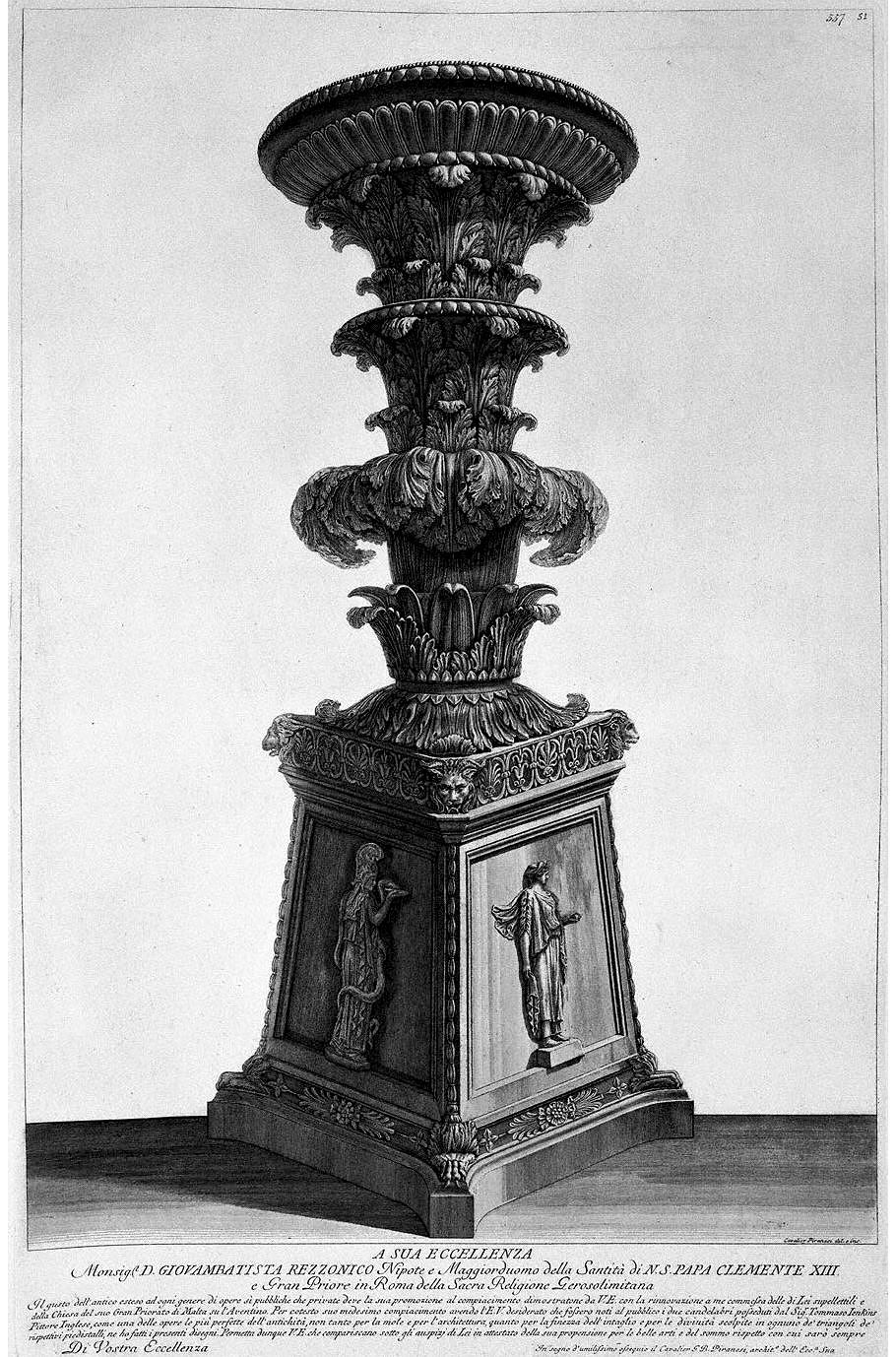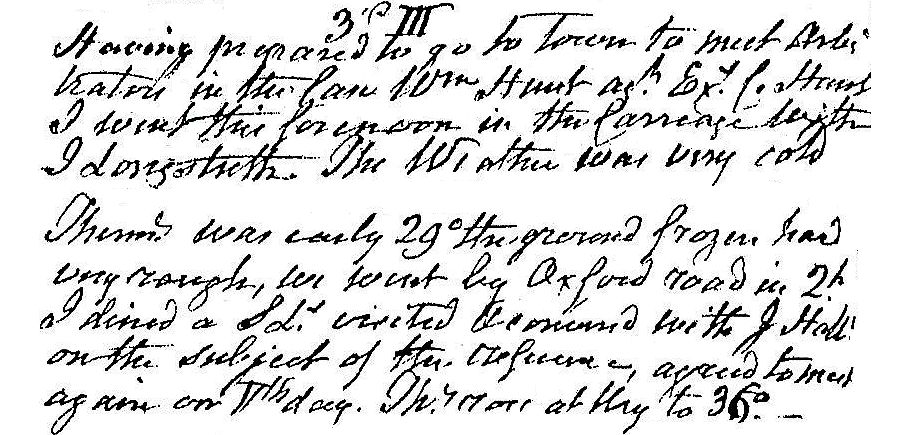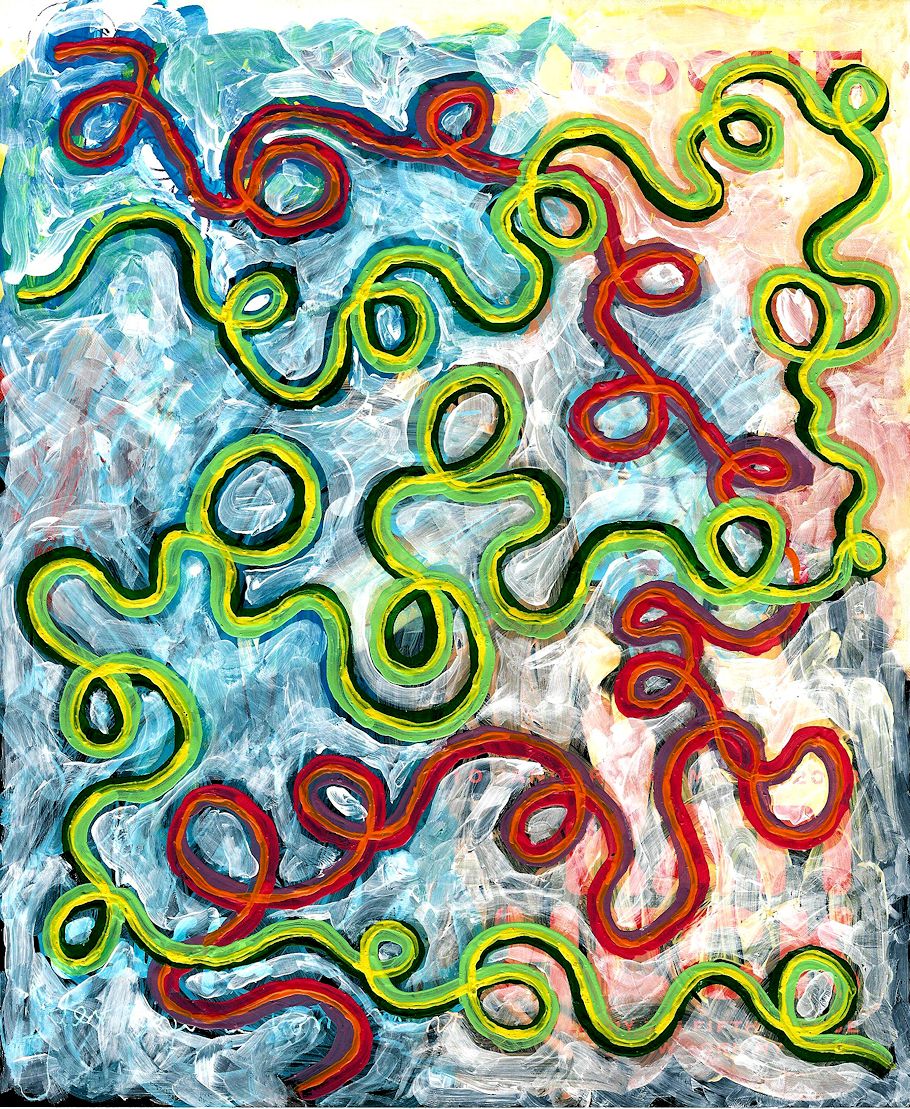3 March 1778 Tuesday
Vases, Candelabra, Grave Stones, Sarcophagi. Tripods, Lamps and Ancient Ornaments volume I

TO HIS EXCELLENCE
Monsig.r D. GIOVAMBATISTA REZZONICO Nephew and Butler of the Holiness of Our Lord Pope Clement XIII and Grand Prior in Rome of the Sacred Religion of Jerusalem
The taste for the antique extended to all kinds of works, both public and private, owes its promotion to the satisfaction shown by Your Excellency with the renovation commissioned to me of your furnishings and of the Church of your Grand Priory of Malta on the Aventine. For this same pleasure, having E. V. wished that the two candlesticks owned by Mr. Thomas Jenkins English Painter were known to the public, as one of the most perfect works of antiquity, not so much for the size and for the architecture, as for the fineness of the carving and for the deities carved in each of the triangles of the respective pedestals, I have made the present drawings. Therefore allow Your Excellency that they appear under your auspices as proof of your propensity for the fine arts and of the supreme respect with which I will always be
Your Excellency
As a sign of humble respect, Cavalier G. B. Piranesi, architect of His Excellency
Cavalier. Piranesi del e inc.
21-22 y.o. Francesco Piranesi 1780
Raccolta de' tempj antichi Parti I

Prospectus of the Temple of Honor and Virtue outside the Porta S. Sebastiano.
A Degrees, who ascended to the Temple. B Door. C Marble columns. D Marble architrave, which supports the upper part of the Laterizia work. E. Remains of Muri from the residence of the Edituo. F Area around the Temple
Franc. Piranesi drew and engraved
3 March 1792
Death of Robert Adam.
3 March 1812 Tuesday

Having prepared to go to town to meet arbitrators in the case Wm. Hunt against C. Hurst, I went this forenoon in the carriage with I. Longstreth. The weather was very cold. Therm. early 29°, the ground frozen, very hard. We went by Oxford Road in 2 hours. I dined at SL's. Visited and concurred[?] with J. Holl on the subject of the reference. Agreed to meet again on Thursday. Therm. rose at Ury to 36°.
3 March 2006
God's will as urban planning?
"God's Will as urban planning?" asked the Roman Senators when they heard of Constantine's intention to found Constantinople as Christian Capital of the Roman Empire.
At least Constantine already had good architectural talent in his blood. With a mother like Helena, and even a mother-in-law like Eutropia, he at least knew what he was doing.
Just for fun, look up the city of "Eutropia" in Calvino's Invisible Cities.
God's will as urban planning?
Careful on the pre-existing part. Constantine's Constantinople was very much a newly constructed city, founded 324 and dedicated 330. Yes there was Byzantium there first (which it would be interesting to know the history and urban fabric of), but Constantine did build a whole new city over (or beside?) Byzantium.
I'd also do a lot more research before making claims about Constantine's Constantinople being "inclusive/socioeconomically and culturally varied." My own curiosity asks just how much Latin was excluded in the new Greek capital.
God's will as urban planning?
I'd guess it's fairly certain that any and all paganism was excluded from Constantine's Constantinople.
It's on record that, coinciding with the time Constantinople was being built, Constantine began outlawing certain pagan sects/cults, especially those where the priesthoods engaged in homosexual practices. (--one of my favorite present Roman Catholic, if not also Greek Catholic, ironies.)
God's will as urban planning?
Regarding "the continuing discrimination they have against women," you might be interested in Church Fathers, Independent Virgins by Joyce E. Salisbury, which shows how and when a lot of the discrimination started. Ironically, in its early centuries, Christianity very much empowered women; it may well have been one of the first human "institutions" where women had a chance to make a choice about their lives. Granted, their choice was to remain virgins, as opposed to being told who they had to marry, but a choice women never even had before, nonetheless. Plus, as usual I suppose, the more wealth a Christian woman had, the more choices she could make for herself. This female freedom even got the pagan Romans upset, and thus even fueled the Great Persecution of the early 4th century.
In Church Fathers, Independent Virgins we see the lives and choices of some notable Christian women, and we see how some notable Church fathers, in their sermons, letters and writings, very much did not like the independence of these women, and thus laid out a whole new restrictive life for Christian woman.
Personally, I see the women as having made the far better choices. Melania the Younger and her grandmother Melania the Elder are two of my favorites, besides Helena and Eutropia, of course.
3 March 2019

Mary Boone's 180 hours of community service hour 15

Mary Boone's 180 hours of community service hour 16
3 March 2023 Friday
The notion of a Piranesi publication entitled Ancient Circuses date back at least to 1804, yet, not till 2022 was Ancient Circuses found to be an actual in-the-works Piranesi project.
Thus...


ANCIENT CIRCUSES.
Plans, details and division of the Circuses
Maximus,
Caracalla,
Eliogabalo,
Flaminius,
Flora,
Nero,
Salust,
Hadrian, still unpublished.
The Circus of Caracalla being the best preserved, we will give the geometric and perspective details, the various restorations, the bleachers, the enclosure around which the chariot race took place, the boxes intended for the magistrates and the emperors. (The latter often took pleasure in racing themselves, driving a quadriga, four-horse chariot); the enclosure from which the chariots left. Besides the ornaments, etc., the bas-reliefs will also be mentioned, in order to make known more positively the uses and the manners adopted for the race. Curious and interesting work.
One volume containing 120 plates
One volume of explanations.
2023...
ANCIENT CIRCUSES.
Plans, details and sections of the Circuses
Nero,
Hadrian,
Domitian,
Flaminius,
Flora,
Salust,
Maximus,
Eliogabalo,
Maxentius.
The Circus of Maxentius being the best preserved, we will give the geometric and perspective details, the various restorations, the bleachers, the enclosure around which the chariot race took place, the boxes intended for the magistrates and the emperors. (The latter often took pleasure in racing themselves, driving a quadriga, four-horse chariot); the enclosure from which the chariots left. Besides the ornaments, etc., the bas-reliefs will also be mentioned, in order to make known more positively the uses and the manners adopted for the race. Curious and interesting work.
Plus,
Basilica of St. Sebastian,
Basilica of St. Lawrence,
Basilica of Sts. Peter and Marcellinus,
Basilica of St. Agnes.
|